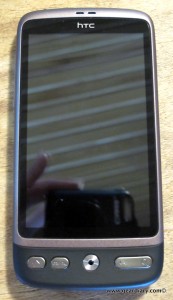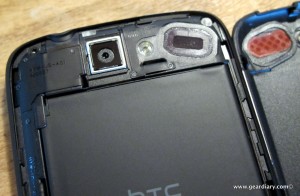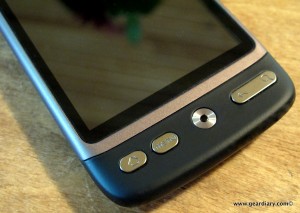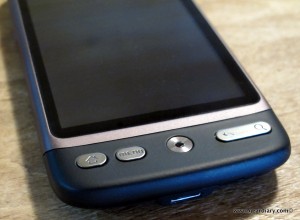Mitchell reviewed the HTC Desire back in April, an Android 2.1 device which at the time was only available in the UK, Europe and Asia, but that’s since changed. US Cellular, a CDMA carrier, has released their branded US version. While in many ways it is basically the same device as the one Mitchell had, there are some differences worth noting. But first, we’ll start with the similarities.
Some of the other phones we’ve seen released as both GSM and CDMA carrier branded versions can appear to be completely different model phones when placed side by side with their counterparts — the unbranded European HTC Diamond vs the US Sprint branded HTC Diamond are examples which immediately come to mind.
The US Cellular HTC Desire looks unchanged from its European twin however, which is a good thing because the original Desire was a solidly built, gorgeously screened, sleekly formed phone complete with a snappy processor. Because of that, Mitchell was so impressed with his review unit that just one week of using it convinced him to sell his brand new iPhone 3GS, so that he could purchase one. Granted, he’s moved on to something else since then, but I’m still impressed that the Desire wowed him that much at the time.
For those not already familiar with the HTC Desire, we’ll do a quick ring-around-the-gadget, a phone that many have dubbed “a Nexus One with Sense” …
The device’s body is largely composed of the grippy, rubberized plastic which HTC has just about made standard on their devices. There is enough matte-silver metal ringed around the screen that the approximately 4.70″ tall x 2.4″ wide x 0.5″ thick phone has a satisfying heft at ~4.5 ounces. The Desire is solid, it doesn’t creak when torqued or squeezed, and it has nicely smoothed edges that feel good when the phone is held. Actually, I can’t stress enough how much I like the Desire’s build quality, and how good it feels in hand. It looks like a sexy device, and because of those smooth edges and rounded shoulders, it is completely caressable. Those of you who live with your phone in hand will understand what I mean by that.
The 3.7″ glass screen dominates the front; the two holes at the top cover the ear speaker, and rather than tuck an indicator LED in this speaker area, it is instead camouflaged by the screen’s opaque bezel to the right of the HTC brand. Under the screen there are three low-profile matte-metallic buttons — Home, Menu, and a rocker with Back and Search — straddling the center optical trackpad. I really like the physical buttons, as there is no chance of touch inaccuracies like those which were seen on the Nexus One; these offer a satisfying but subtle click when pressed.
The Desire’s top edge holds the power button/screen dimmer and a 3.5mm headphone jack.
On the left side there is a long volume rocker …
On the bottom a standard microUSB port and a microphone …
And the right side is empty.
The entire back of the Desire is composed of the removable plastic battery cover, which is peeled off by sticking a fingernail into a slot behind the power button. I intensely dislike this method of battery door removal, but fortunately it doesn’t seem necessary to open the case as often when there is no SIM card to swap out. A red-ringed 5 megapixel camera lens, a single LED “flash”, and the external speaker are located on the back.
One reason you might want to open the case is to exchange the included 8GB microSD for one of the new 32GB cards; available for under $100, buying one will immediately allow your Desire to hold a satisfying number of music and movie files.
Taking a look at the specifications copied from the U.S. Cellular site, the biggest differences I immediately see between the US and Euro versions of the Desire are that the 3.7” 480×800 AMOLED capacitive display screen that Mitchell enjoyed is no longer present. But you won’t even miss it! My husband, Kevin, is an iPhone 4 user, too — and his first reaction when using the Desire (to play Angry Birds, I might add), was to say that the screen was “gorgeous.” It really is.
Battery sizes are the same, but estimates on talk and standby times have been shortened dramatically. Here’s an example of what I mean: The U.S. Cellular version is listed as having a talk time of up to 5 hours, whereas the Euro version said up to 400 minutes on GSM, or 6.66 hours. The U.S. Cellular version says it will last for 10.5 days on standby, whereas the Euro version said up to 340 hours, or 14.17 days. I am sure that the actual figures for the phone are even a little bit less than those given. Evidently the US Desire also weighs about 0.3 ounces less than the European; go figure.
The Basics
- 3.7″ WVGA Super TFT touchscreen 480 x 800
- AndroidTM 2.1 (Eclair)
- 1 GHz snapdragon processor
- 5.0 Camera/Camcorder with LED flash
- Full HTML browser with Flash lite support
- Stereo Bluetooth capable
- On screen QWERTY keypad
- Wi-Fi
Technical Specifications
- E911 Ready
- CDMA/EVDO 800/1900 MHz
- Talk Time up to 5 hours*
- Standby Time Up 10.5 days*
- Battery: 1400mAh
- Dimensions: 4.70″ x 2.36″ x 0.47″
- Weight: 4.46oz.
Pre-Loaded Apps
- My Contacts Backup
- Toneroom Deluxe
- Your Navigator Deluxe
- Friendstream
- Facebook®
- Peep (Twitter)
- Footprints
- My Space
- HTC Weather
- Stocks
- QuickOffice
- GmailTM
- Google MapsTM
- Android MarketTM
- Google TalkTM
- YouTubeTM
Included
- Battery
- Travel charger
- 8GB microSDTM Card
U.S. Cellular has kept tacked on and branded applications to a minimum, adding only a static welcome screen, a U.S. Cellular Scene, and the apps “My Contacts Backup”, “MySpace”, “Tone Room Deluxe”, and “Your Navigator”. Perhaps the best software surprise is that there are no U.S. Cellular imposed issues with downloading non-Market apps, and the only issues you’ll have are with apps that require Android 2.2 (Froyo) to run. Yes, therein lies the rub: the Desire was not released with the most current OS flavor available, which is such a shame because it really is an otherwise lovely device.
So while I am finding things to pick about, I should mention that the camera is mediocre at best. I can’t help but compare it to the one on my iPhone, and while it has the same number of megapixels and the same LED-flash, and while it could be argued that it is “good enough” for a phone’s camera … I’m just not impressed. The one saving thing is that you can at least press the LCD to let the camera know where you want it to focus and adjust for lighting, which as you can see in these pictures can make a huge difference on how things come out.
This is with the camera focused on the pony’s face
This is with the camera focused on the grass in the yard beyond the pony
this is with the lighting focused on the barbecue pit
The other caveat is battery life; I can’t quite make it through a full day using the Desire on a single full charge. My problem is not that I make a lot of calls; instead I spend a huge amount of time texting, reading, surfing, and checking email … a huge lot of time. Now don’t get me wrong, an iPhone can’t make it through a full day with me without being topped off either, but I tend to look at the iPhone as the worst case scenario, and … the Desire isn’t much better.The difference is that at least the Desire has a removable battery, so if this were my regular phone I could simply get myself a couple of spares.
And … that’s it. I really don’t have anything else to complain about.
So how does the Desire perform as a phone? The first thing that you’ll notice is that the Phone soft-button is at the bottom of every screen; you aren’t going to have to deal with searching for the phone button in a sea of on-screen apps, so that is a plus. Call quality is good; U.S.Cellular is not even “technically” available in my area, so the phone was on digital roam and WiFi the entire time I was testing it. However it performed like a champ with no dropped calls. Present is one of the HTC phone features that I think is nifty, even if I haven’t really needed it much: when a call is coming in, you can flip it over to silence it. So it boils down to this: the Desire is a phone that feels good, works well, and is just as much a “phone” as it is a mini-computer.
The US Cellular HTC Desire is available directly from the carrier.
MSRP: $199.99 “After $80 mail-in rebate that comes as a Visa® debit card. Requires a Belief Plan w/ Data Plus and/or new 2-year agreement. Applicable data plan required.”
What I Like: Solid build; feels great in hand; speedy processor; beautiful screen; hardware buttons with great tactile feedback;
What Needs Improvement: Ships with Android 2.1; battery life is not great; camera is only “okay”
































RT @GearDiarySite: Android Device Review: U.S. Cellular’s HTC Desire http://goo.gl/fb/YYeHG
Android Device Review: U.S. Cellular?s HTC Desire #gadgets http://bit.ly/bDsTZQ
RT @geardiarysite: Android Device Review: U.S. Cellular's HTC Desire http://bit.ly/c9If1V
Android Device Review: U.S. Cellular’s HTC Desire #ipad